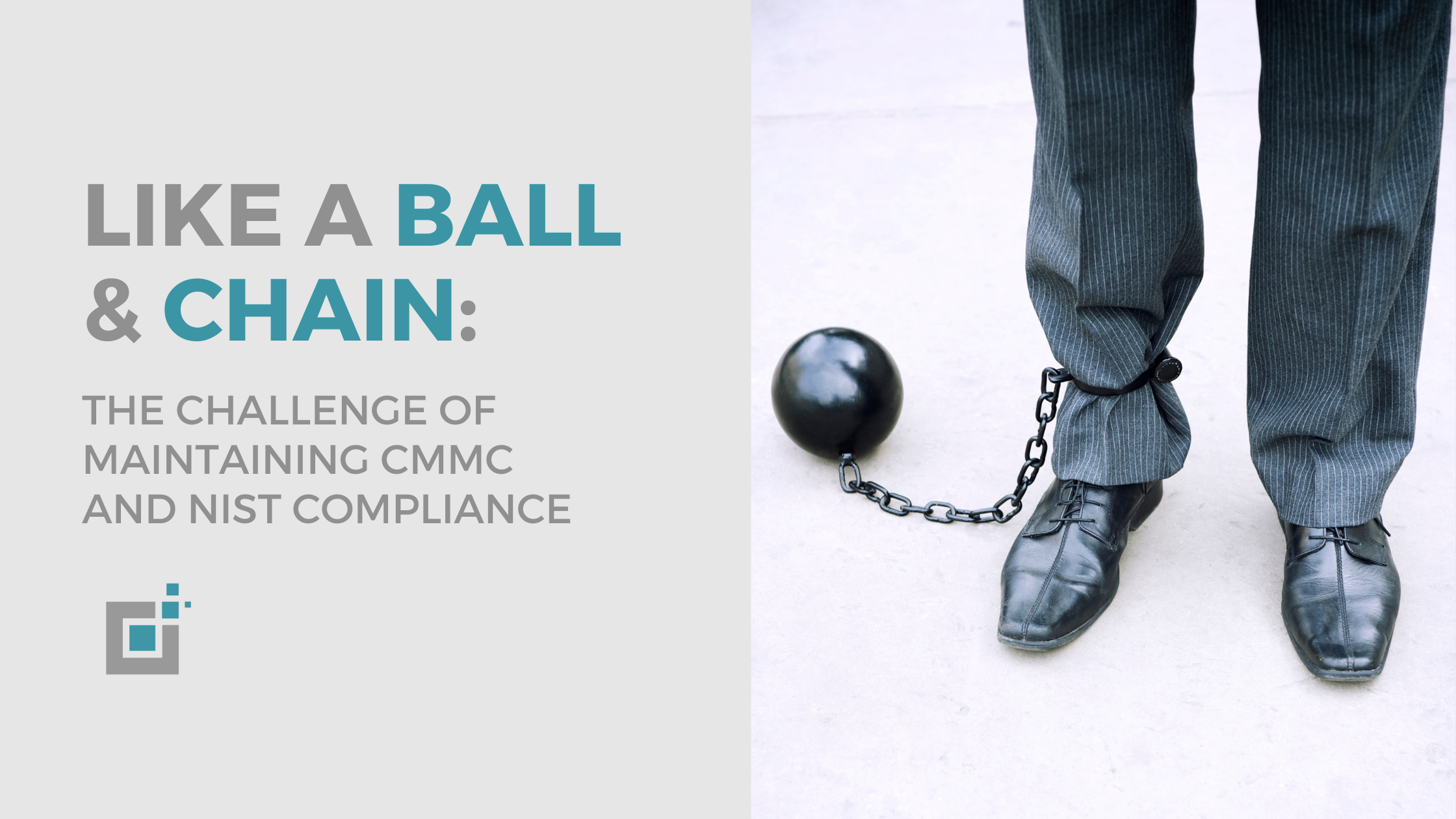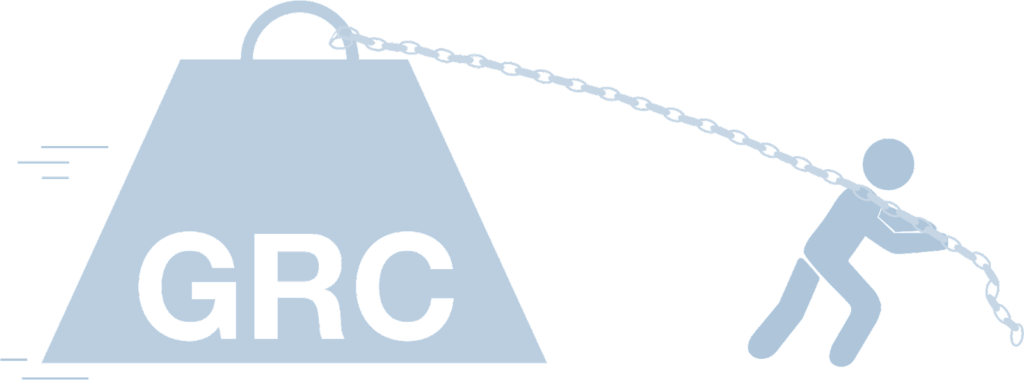
Complying with the CMMC / NIST 800-171 framework can be likened to a heavy chain, where each link represents a specific task or requirement. The unmanageable amount of tasks required for full compliance burdens this chain, making it increasingly difficult to pull.
Let’s break down the chain into several links to illustrate this concept:
11 Links In The Chain Of CMMC/NIST 800-171 Compliance
1. Document Inventory: The first link involves creating an inventory of all documents and information systems that handle controlled unclassified information (CUI). This includes identifying the location, classification, and access controls for each document.
2. Access Controls: Establishing access controls is another crucial link. It involves defining user roles, implementing robust authentication mechanisms, and enforcing strict authorization protocols to ensure only authorized individuals can access CUI.
3. System Security Plans: Developing system security plans is a vital link that requires documenting the security controls and procedures in place for protecting CUI. This involves conducting risk assessments, defining incident response protocols, and establishing security monitoring mechanisms.
4. Continuous Monitoring: The next link involves implementing continuous monitoring processes to ensure ongoing compliance. This includes regular vulnerability scanning, security event logging, and analysis to promptly identify and address any security risks or breaches.
5. Incident Response: Creating an effective incident response plan is an important link in the chain. It requires establishing protocols for detecting, reporting, and responding to security incidents promptly. This includes conducting investigations, mitigating the impact, and implementing corrective actions.
6. Employee Training: Training employees on security awareness and best practices is an essential link. It involves educating staff on the importance of safeguarding CUI, recognizing potential threats, and understanding their roles and responsibilities in maintaining compliance.
7. Physical Security: Ensuring physical security measures is another significant link. It involves protecting facilities, equipment, and storage areas that house CUI. Implementing measures such as access controls, surveillance systems, and visitor management protocols are part of this link.
8. Risk Management: Conducting regular risk assessments is a critical link that helps identify vulnerabilities and threats to CUI. This involves evaluating security controls, analyzing potential risks, and prioritizing efforts to mitigate those risks effectively.
9. Configuration Management: Maintaining configuration management is a vital link. It requires managing the configuration of information systems to prevent unauthorized changes, ensure proper version control, and maintain the integrity of CUI.
10. System and Communication Protection: Protecting information systems and communication channels is an essential link. This involves implementing firewalls, encryption, and intrusion detection systems to secure networks and prevent unauthorized access to CUI.
11. Incident Reporting: Reporting security incidents to the appropriate authorities is a crucial link. Organizations must adhere to specific reporting requirements outlined by NIST 800-171, ensuring that incidents are properly documented and reported in a timely manner.

Each of these links represents a specific task or requirement within the NIST 800-171 framework. As the chain grows longer, the weight of the data required for full compliance becomes increasingly unmanageable. Organizations must dedicate significant resources, time, and effort to ensure each link is strong and well-maintained to successfully pull the heavy weight of full compliance with NIST 800-171.
GRC technologies can turn unmanageable to manageable.
Implementing a Governance, Risk, and Compliance (GRC) system can significantly alleviate the burden of compliance and make it more manageable.
A GRC system streamlines and centralizes various compliance-related activities, including policy management, risk assessment, control implementation, and monitoring. By utilizing a GRC system, organizations can automate routine tasks, such as document management, compliance tracking, and reporting, reducing manual effort and human error. The system provides a unified view of compliance requirements, enabling organizations to align their processes with regulatory standards, such as NIST 800-171, and efficiently track their progress toward compliance. With real-time visibility into compliance status, organizations can proactively identify and address gaps or issues, mitigating risks effectively.
Additionally, a GRC system helps streamline collaboration among different departments and stakeholders, fostering better communication and coordination to ensure consistent compliance across the organization. By providing a structured framework and automated tools, a GRC system empowers organizations to navigate the complex landscape of compliance with greater ease, ultimately making the task more manageable.
Integrating AI into a GRC system can further revolutionize compliance management by providing real-time insights, and streamlining processes. It accelerates documentation and reporting as well as reduces manual effort. AI’s natural language processing simplifies policy management and training. By leveraging AI in GRC systems, organizations enhance efficiency and adaptability, making compliance more manageable in a dynamic regulatory landscape.
Achieving A Successful GRC Workflow: The Steps Required
Managing Governance, Risk, and Compliance (GRC) can be an immense and challenging task, comparable to a chain with numerous links, where each link represents a specific GRC task or requirement. Achieving a successful GRC function can be likened to a heavy weight that needs to be pulled along this chain. Let’s explore this analogy further to understand the unmanageable amount of effort involved.
1. Chain of GRC Tasks: The GRC landscape encompasses various tasks such as policy creation, risk assessment, regulatory compliance, internal controls, audit management, incident response, and more. Each of these tasks represents a link in the chain, forming a comprehensive GRC program.
2. Interconnected Links: The GRC tasks are interdependent and interconnected. Failure to address one link adequately can weaken the entire chain. For example, lacking proper risk assessments can lead to inadequate controls or non-compliance with regulations. Thus, managing GRC requires attention to all aspects and a holistic approach.
3. Complex Compliance Demands: GRC compliance involves adhering to a multitude of regulations, industry standards, internal policies, and contractual obligations. Each requirement adds weight to the chain, making it harder to pull. Organizations must navigate through an ever-evolving and diverse landscape of compliance obligations, increasing the complexity of the GRC management process.
4. Resource Intensive: GRC management demands significant resources in terms of time, personnel, and technology. Organizations must allocate personnel for policy creation, risk assessments, compliance monitoring, audit preparation, and incident response. Moreover, they need suitable tools and technologies to streamline these processes effectively.
5. Constant Adaptation: Risk and compliance requirements are not static; they evolve continuously. New regulations emerge, industry standards get updated, and business landscapes change. As a result, organizations must be agile and adapt their GRC strategies accordingly. This constant adaptation adds more weight to the compliance burden, making it increasingly difficult to manage.
6. Cross-Functional Collaboration: GRC management typically involves multiple departments and stakeholders within an organization. Collaboration among various teams, such as legal, compliance, IT, finance, and operations, is crucial. However, coordinating efforts, aligning objectives, and ensuring consistent compliance across departments can be a daunting task, adding complexity to the GRC chain.
7. Reporting and Documentation: Effective GRC management requires meticulous documentation and reporting. Organizations must maintain comprehensive records of policies, risk assessments, compliance activities, audit findings, and incident responses. Generating accurate reports and maintaining proper documentation is time-consuming but essential for demonstrating compliance.
8. Constant Monitoring: GRC is not a one-time effort but an ongoing process. Organizations need to monitor their GRC activities continuously, ensuring compliance is sustained over time. This involves monitoring changes in regulations, assessing emerging risks, conducting internal audits, and responding promptly to incidents. The perpetual nature of GRC management further amplifies the effort required.
In summary, managing CMMC with GRC is like a chain with each link representing a task and full compliance acting as a heavyweight illustrates the magnitude of effort involved. The interconnectedness of GRC tasks, the complexity of compliance demands, the need for resources, constant adaptation, cross-functional collaboration, documentation, and ongoing monitoring collectively contribute to the unmanageable amount of effort required to pull the weight of full CMMC compliance.
For risk and compliance support, contact Cential via our contact form or stay tuned for our upcoming whitepaper focused on how to simplify and streamline your CMMC compliance processes.
